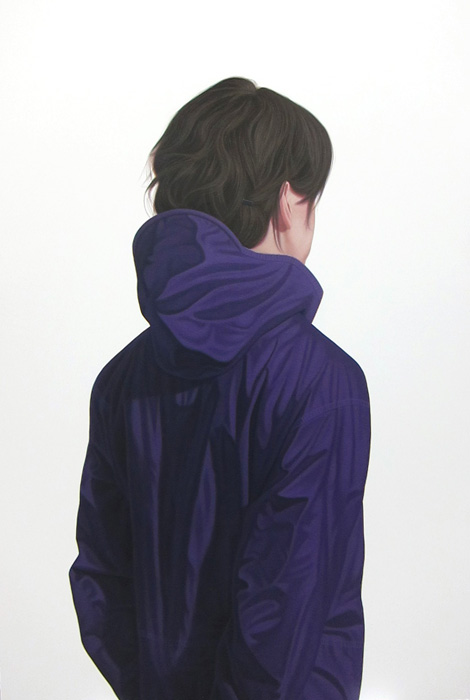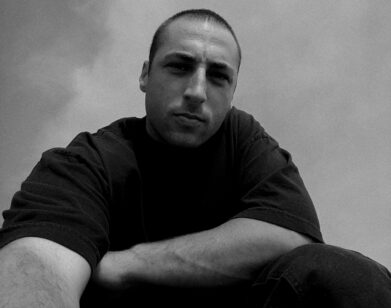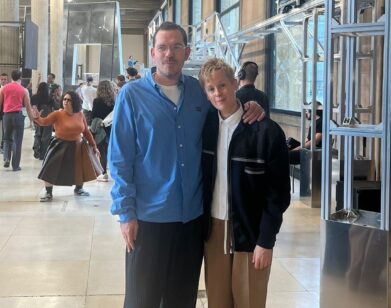Karel Funk: Know the Artist by His Uniform

PORTRAIT OF KAREL FUNK, PHOTO BY JACK SIEGEL
Though Karel Funk’s intimate paintings depict the backs of his sitters, they do not turn their backs on the Romantic tradition of portraiture. Set against flat backdrops and painted at just larger-than-life, Funk represents what we assume to be young men, viewed from behind, in crisp, colorful hooded jackets. The mystery of the sitter’s identity is suspended in the details of their costume, and the artist’s career-long fixation on a single subject. His new show at 303 Gallery sees the artist, in part, focusing on the details of the head and the textures of shaggy haircuts, with renewed interest in a Classical color palette. Menswear designer Patrik Ervell has long admired Funk’s work, and the two share a similar interest in the romance of bodies that are blank but never nondescript. This is their first conversation:
PATRIK ERVELL: There are references in the poses you use, to the work of Caspar David Friedrich, among other Northern European Romantic painters, which creates the impression of a figure in isolation, even from the viewer. Do you feel a relationship to the Romantic tradition?
KAREL FUNK: I do feel a similarity between their works and mine. But I channel the feeling they are depicting through everyday urban banality. When I lived in New York, I was inspired by my experience of the overwhelming density of people, at a crowed corner or in a busy subway car. People can be so close to each other, even touching, and yet completely oblivious to the person next to them.
PHOTO BY JACK SIEGEL
ERVELL: Would you compare that process of the figure occupying space to meditation? What about for the viewer?
FUNK: I wouldn’t go so far as to say that they are in a sublime state, but people sometimes appear to try and leave themselves, so that the close proximity to a complete stranger is bearable. There is the feeling of a journey, maybe in a way that someone would experience in some Romantic paintings. I guess I do try to pose the figures in my paintings in a way that is similar to how Friedrich did. I want them to be faced away from the viewer, and engaged in their own thoughts. This way the viewer can come right up to the person in the painting and feel free to examine every detail, be a voyeur, and not worry about any eye contact.
ERVELL: If Friedrich’s figures were “contemplating the moon,” what are your figures contemplating?
FUNK: I think the figures in my paintings are sometimes contemplating a moment of solitude. As I said in response to your first question, maybe they are just trying to escape a busy urban environment for a short time to rejuvenate, before the “walk” sign appears.
ERVELL: The kind of garment the figure is wearing is obviously important to you. As a designer, I think this is what initially drew me to your paintings. What does this kind of hooded nylon outerwear garment signify for you? Or does it signify nothing?
FUNK: The jackets I paint are a meeting place somewhere between Renaissance painting and common everyday Gore-Tex windbreaker jackets that everyone has. When I lived in New York I spent many Sunday mornings going to the Met to look at the Renaissance paintings. I would get carried away in the details of fabrics. I just loved the attention to detail, and the care taken to design all the folds and creases. These paintings are such a source of inspiration to me that I wanted to bring them into my paintings.
ERVELL: For me, a hooded windbreaker conjures ideas of protection and utility but also a kind subtle drama. Do the jackets have a specific, or similar, referent in your painting?
FUNK: I think they signify averageness. Everyone has one. Sometimes they are purely about function; they’re a shell that protects you. But I always come back to the thought that these jackets are about a timeless fashion that people have enjoyed for centuries. They’re a fashion that’s very flexible.
WORK BY KAREL FUNK IS ON VIEW THROUGH MAY 15, 2010. 303 GALLERY IS LOCATED AT 547 WEST 21 STREET, NEW YORK.
ABOVE: UNTITLED #39. COURTESY 303 GALLERY.






